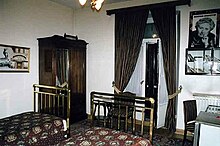| Dame Agatha Christie, DBE | |
|---|---|
 | |
| Born | Agatha Mary Clarissa Miller 15 September 1890 Torquay, Devon, England |
| Died | 12 January 1976 (aged 85) Wallingford, Oxfordshire, England |
| Pen name | Mary Westmacott |
| Occupation | Novelist/Short story writer/Playwright/Poet |
| Nationality | British |
| Genres | Murder mystery, Thriller, Crime fiction, Detective, Romances |
| Literary movement | Golden Age of Detective Fiction |
| Spouse(s) | Archibald Christie (1914–1928) Max Mallowan (1930–1976; her death) |
| Children | Rosalind Hicks (1919–2004) Father: Archibald Christie |
| Signature | |
www.agathachristie.com | |
Dame Agatha Christie DBE (15 September 1890 – 12 January 1976) was a British crime writer of novels, short stories, and plays. She also wrote romances under the name Mary Westmacott, but she is best remembered for her 66 detective novels and 14 short story collections (especially those featuring Hercule Poirot or Miss Jane Marple), and her successful West End plays.
According to the Guinness Book of World Records, Christie is the best-selling novelist of all time. Her novels have sold roughly four billion copies, and herestate claims that her works rank third, after those of William Shakespeare and the Bible, as the most widely published books.[1] According to Index Translationum, Christie is the most translated individual author, with only the collective corporate works of Walt Disney Productions surpassing her.[2] Her books have been translated into at least 103 languages.[3]
Agatha Christie published two autobiographies: a posthumous one covering childhood to old age; and another chronicling several seasons of archaeological excavation in Syria and Iraq with her second husband, archaeologist Max Mallowan. The latter was published in 1946 with the title, Come, Tell Me How You Live.
 The room where she wrote "The Murder on the Orient Express".
The room where she wrote "The Murder on the Orient Express".
Agatha Christie's first novel The Mysterious Affair at Styles was published in 1920 and introduced the long-running character detective Hercule Poirot, who appeared in 33 of Christie's novels and 54 short stories.
Her other well known character, Miss Marple, was introduced in The Tuesday Night Club in 1927 (short story) and was based on women like Christie's grandmother and her "cronies".
During the Second World War, Christie wrote two novels, Curtain, and Sleeping Murder, intended as the last cases of these two great detectives, Hercule Poirot and Jane Marple. Both books were sealed in a bank vault for over thirty years and were released for publication by Christie only at the end of her life, when she realised that she could not write any more novels. These publications came on the heels of the success of the film version of Murder on the Orient Express in 1974.
Like Sir Arthur Conan Doyle with Sherlock Holmes, Christie was to become increasingly tired of her detective Poirot. In fact, by the end of the 1930s, Christie confided to her diary that she was finding Poirot “insufferable," and by the 1960s she felt that he was "an ego-centric creep." However, unlike Doyle, Christie resisted the temptation to kill her detective off while he was still popular. She saw herself as an entertainer whose job was to produce what the public liked, and the public liked Poirot.
Poirot is the only fictional character to have been given an obituary in The New York Times, following the publication of Curtain in 1975.



